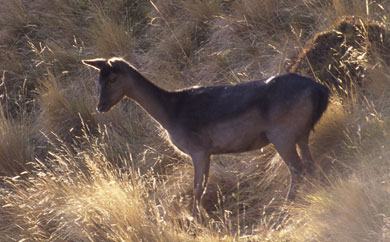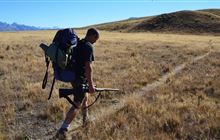Fallow deer hunting
Introduction
Fallow deer were among the first to be successfully introduced to New Zealand.Find out about fallow deer (Dama dama dama).
Description

Fallow deer
PHOTO: Gordon Roberts ©
Size: Males 900-1000 mm shoulder height and 60-85 kg in weight with females smaller at 850-900 mm shoulder height and weighing 30-50 kg.
Colour: The most variable of any deer species in New Zealand with four quite distinctive colour phases:
- Melanistic: In New Zealand this is the most common colour encountered. Brown-black back with paler grey-brown underside and neck. There are no spots or tail patch.
- Common: Light red brown sides and back with conspicuous white spots and a black stripe down the back. Colour grey black in winter.
- Menil: A paler version of the 'common phase' fallow, in summer coat, but doesn't attain the darker winter coat.
- Leucistic: In young animals a creamy colour which with age (by second summer) become's pure white. Such white animals are not albino having dark eyes and nose.
Antlers: Present on males only and cast each year in October or November with replacement antlers developed by February. Typical antlers on older deer (yearlings have unbranched spikes) have a round main beam at the base which becomes flattened and palmated at the top end. On the lower beam are brow and trez tines and the palmation has points on the rear edge pointing backwards.
Social behaviour: Fallow tend to be gregarious and where undisturbed can form quite large groups containing both sexes of all ages. With hunting pressure, the normal sequence is small groupings with separate herds of male and female coming together during the rut period of April-May.
Fallow eat a wide range of plants, including fungi, and favour lowland areas such as river flats and lower valley sides. They live in indigenous or exotic forests and often use adjacent farmland for feeding.
Fallow are quite vocal barking when disturbed, females and young bleating to each other and males groaning repeatedly during the rutting period.
Reproduction: Rut begins in April with males establishing territories, marked by scrapes in the ground into which the male urinates.
Females usually don't breed till 16 months old with young males, less than 4 years old, kept from mating by older males. Females are attracted to the males rather than a male herding them up in a harem like some other deer species. Usually females give birth to a single fawn, twinning is rare.
Gestation period: About 234 days.
Birthing: December-January.
Nomenclature: Male = buck. Females = doe. Young = fawn.
Where to hunt fallow deer
Fallow deer can be found in both the North and South Islands of New Zealand on public conservation land and private property.
You can use the hunting block search function to find hunting areas that have fallow deer.
Search for a hunting block that has fallow deer.
North Island
- South Kaipara: Mainly in Woodhill Forest where hunting is managed by the Woodhill Fallow Management Council, which runs an annual ballot system for this small herd.
See Woodhill fallow hunting information - Waikato: Small herd within Te Miro and Te Tapui Scenic Reserves. Hunting is balloted March-April.
- Tauranga: Fallow present within Otanewainuku and Otawa Forests.
- Wanganui: Large herd on both private and public conservation land.
South Island
- Nelson: Mount Arthur (Kahurangi National Park) and Aniseed Valley (Mt Richmond Forest Park).
- Paparoa Range: Small herd of fallow deer in the eastern Paparoas between Stoney Creek and Big River.
- Wakatipu: There are various herds of fallow scattered around the Wakatipu area with the best known population in the Greenstone/Caples Recreational Hunting Area.
- Blue Mountains: Large herd in Blue Mountains Recreational Hunting Area. Divided into hunting blocks which are balloted monthly from February through to the end of November.
As well as the above areas, fallow deer have become established, through farm escapes or illegal liberations, in various areas and to hunt there you will need private landowner permission.
Tips for hunting fallow deer
|
Characteristics/behaviour |
Hunting response |
|---|---|
|
Fallow are medium sized deer. |
Rifle calibres of .243 and above are suitable for shooting fallow deer. |
|
Possess good eyesight and acute sense of smell. |
When hunting utilise available cover and hunt into the wind. |
|
Fallow feed mainly at dawn and dusk in summer spending much of the day resting in heavy cover and in winter tend to feed most of the day. |
Hunt for fallow when feeding as easier to locate and stalk. |
|
Fallow deer rut April to mid-May and bucks can become preoccupied with attracting does. |
If hunting for trophies the rut is a good time to locate and secure trophy animals. |
|
During the rut bucks may engage in quite intense fights which can result in points being broken of antlers. |
Hunt early in the rut to lessen chance of trophy secured having broken points. |
Hunting seasons and ballots
In New Zealand, there is no seasonal restriction to hunting fallow deer, meaning generally they can be hunted throughout the year. However there are instances where restrictions apply for specific reasons and periods when hunting is favoured.
Specific restrictions
- Some areas may be closed during periods of high fire danger. (This is almost an annual event in exotic forest herds.)
- Due to high use, some locations run block systems where blocks are allocated by ballot or first registered.
- Occasionally an area may be closed on a temporary basis to enable research or other management to be undertaken without being compromised by hunting.
It is important to check for these conditions with the DOC office nearest the hunting area.
Favoured hunting periods
- The rut (April-May) is when the bucks are occupied in attracting the attention of does and are less cautious than other times.
- Spring is another favourable time of the year to hunt fallow deer. They come out of the forest to feed on new grass and shrub growth.
International travel with hunting trophies
You may need CITES documentation to enter or leave New Zealand with your hunting trophy.

